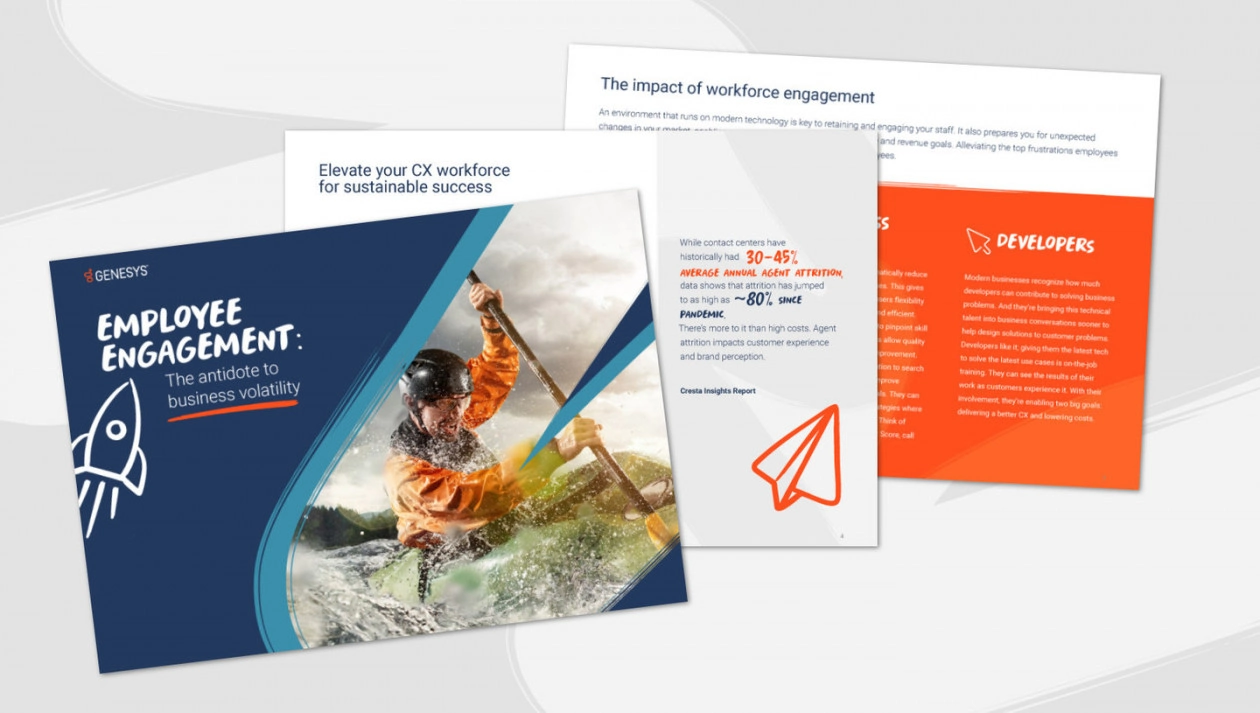Your Genesys Blog Subscription has been confirmed!
Please add genesys@email.genesys.com to your safe sender list to ensure you receive the weekly blog notifications.
Subscribe to our free newsletter and get blog updates in your inbox
Don't Show This Again.

Burgeoning digital commerce. Changing customer and employee expectations. The rise of remote and hybrid working. We’ve seen these trends take shape over the past three years – and they’ve transformed the way many of us work. Successful companies have gained ground in becoming more customer-centric. But they’ve largely failed to become employee-centric, especially when it comes to their contact centre agents, supervisors and other customer satisfaction specialists.
Many customer experience (CX) leaders now express contradictory views about their frontline employees, according to the MIT Technology Review Insights report sponsored by Genesys. Eighty-seven percent of respondents identify CX as a strategic differentiator of their brands.
But a majority of respondents noted being more concerned with the challenge of finding new employees than retaining those they already have. And while many companies are focused on finding and hiring the right candidates in a competitive job market, they’re losing sight of the value of their current contact centre staff.

Keep the employees you have — and keep them happy.
While 96% of respondents consider hiring new employees to be challenging and 62% struggle with increasing recruitment costs, just one-third identify high staff turnover as a problem. That represents a traditional contact centre mindset — one that’s more focused on productivity and efficiency and accepts a relatively short employee tenure.
For decades, CX work has been built for efficiency — optimised for metrics like average handle time. But we’re now in the “Great Reshuffle” — a period of unprecedented change where employees are questioning how they work and why.
Organisations that don’t recognise and solve their retention problem will spend more resources scrambling for talent. Workers are demanding flexibility; control over their schedules; processes and technology that enable them to succeed. And they want access to learning and career development opportunities.
We’re going to examine the “people paradox” illuminated in this new global MIT research. And we’ll explore how progressive organisations are thinking more strategically about their CX staff — promoting employee retention and career development by transforming their company culture and work environments. They’re striving to solve their recruitment problem by not losing their people in the first place.
The traditional CX model, which is built on slim margins and hourly wages is broken, noted experts interviewed in the MIT report. And that’s causing massive contact centre attrition.
Now, recruiting new employees has become the most significant workforce-related challenge for contact centre leaders today, according to the MIT report. Fifty-four percent of surveyed executives find recruiting to be “challenging” and another 42% find it “extremely challenging.” But just 32% of respondents feel that way about employee turnover.
This paradoxical view on retaining employees versus recruiting new ones extends to career development. While CX leaders claim it’s not difficult to meet employee workforce expectations or develop solid career paths for them, 76% feel that low employee morale is a problem. And 62% are struggling with the increasing cost of employee turnover.
Most organisations have been forced to accommodate work-from-home or hybrid models. Now, millions of contact centre agents are used to working remotely — and they enjoy the freedom in choosing if and when to come into the office. These numbers are expected to grow.
The survey finds that hybrid or remote jobs offer significant CX benefits, including:
Now that organisations have adjusted to these models, jobs that once were location-dependent are now available to a wider pool of candidates, such as on-demand “gig” workers who might be “super users” of your products.
But remote work also presents plenty of risks for contact centres. Specific concerns in the MIT survey included lower productivity (51%), a negative impact on culture and teamwork (42%) and reduced collaboration around ways to optimise CX (41%).
To maximise flexibility for their employees and manage the risks of remote work, organisations must rethink their overall staffing model and explore the skills and competencies needed for future success. They can achieve these goals with the help of artificial intelligence (AI)-powered workforce engagement management capabilities, such as:
Workforce forecasting: Create accurate forecasts in minutes, leaving more time to focus on employee performance, skill development and coaching.
Flexible scheduling: Empower your team to take ownership of their work-life balance. Increase scheduling transparency and reinforce a feeling of fairness. Allow employees to view schedules, submit time-off requests and manage their own time from their smartphones.
Gamification: Bring out your employees’ inner competitiveness — and build camaraderie across groups — as you motivate them with a fun, interactive environment.
Learning and growth is at the heart of a good company culture. It’s now the top factor that people say defines an exceptional work environment.
Sixty-nine percent of respondents in the MIT survey expect contact centre work to become more specialised as companies adopt cloud platforms and AI tools. And agents and supervisors will continue to move away from transactional interactions to more personalised, empathetic and proactive interactions.
More than 90% of respondents said they’ll need customer experience employees to possess skills like emotional intelligence, data and analytics skills, and specialised product knowledge.
This means organisations need to empower employees with performance management tools that enable them to build their proficiency on digital channels and constantly learn new skills.
Skill building and skills-based planning stand out as the most impactful places for “Learning & Development (L&D)” leaders to make progress amidst “2022’s storm of urgent priorities,” according to LinkedIn in its “2022 Workplace Learning Report.”
Consider these statistics cited in the LinkedIn report:
Internal mobility is another key to employee retention. Companies that excel at internal mobility are able to keep their employees almost twice as long as companies that struggle with it — an average of 5.4 years compared to an average of 2.9 years — according to the LinkedIn report.
Your employees are unique individuals with specific skills — they’re assets, not costs. When you think about them that way, you can personalise the employee experience — just like you do with customers.
Modern workforce engagement management technologies focus on generating a positive employee experience, driving the right behaviours, performance and culture — all integrated into a single solution.
When you give your employees flexibility, control over their schedules, contact centre solutions that allow them to succeed and career development opportunities, they’ll deliver a great customer experience. And they’ll reward you by staying with your company longer.
Explore our new ebook “Employee engagement: The antidote to business volatility,” to discover learn how to unleash your organisation’s greatest superpower: your people.
Subscribe to our free newsletter and get the Genesys blog updates in your inbox.